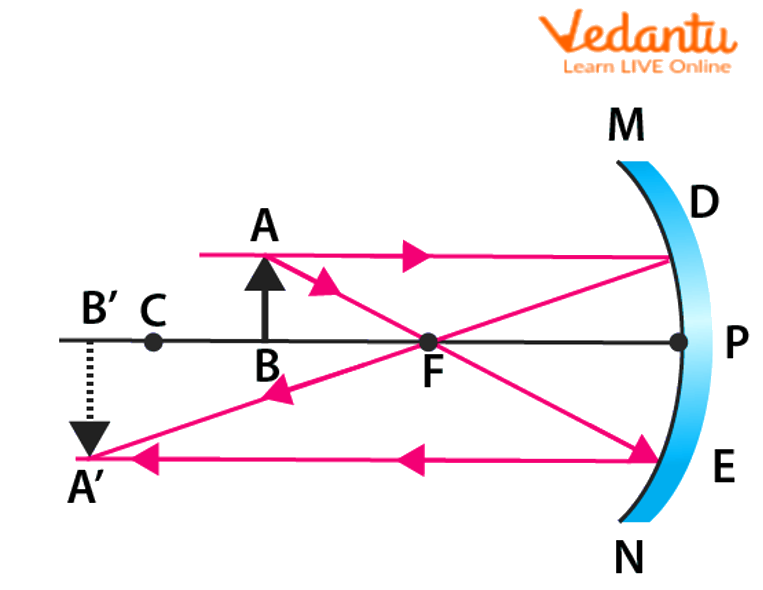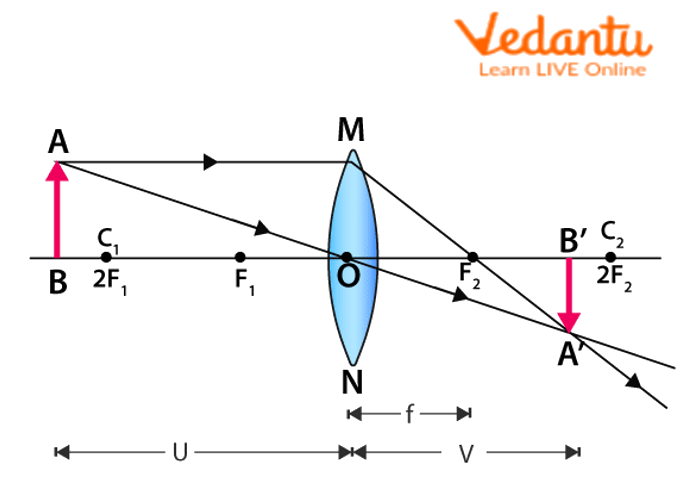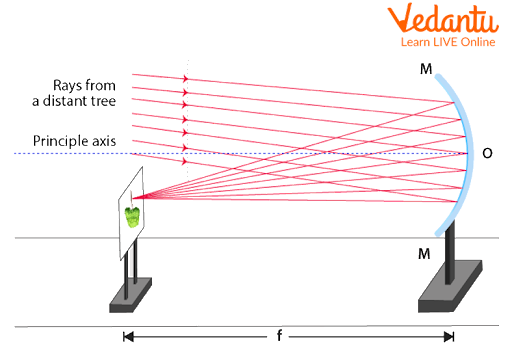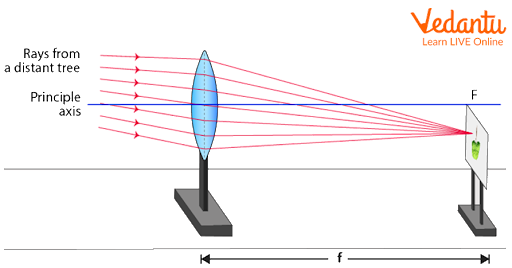




Step-by-Step Guide to Measuring Focal Lengths in Class 10 Physics for Exam Success
Physics Experiment - An Introduction to Determination of Focal Lengths of Concave Mirror and Convex Lens
We all have used a magnifying glass at some point or the other to enlarge the object we are viewing. Why is it that at a particular point from the glass the object is magnified to the maximum? We have often seen in our homes Dish TVs and in the pictures of satellites the antennae has a curved surface with a large bulb at some distance from it. Likewise, there are many instances of starting a fire using a magnifying glass by converging the sun's rays at a point on the paper, keeping at a fixed distance. This special distance is known as the focal length.
In this simple experiment, we are going to learn how to determine the focal length of a concave mirror with sign and the focal length of convex lens with sign.
Table of Contents
Aim
Theory
Procedure
Observations
Result
Aim
To determine the focal length of Concave mirror and Convex lens with sign.
Apparatus Required
A concave mirror
A convex lens
A white cardboard
One mirror holder
One lens holder
One image holder
A measuring scale
Theory
The Focal length (f) of curved mirrors and lenses is the distance from their optical centers to a point where the light rays meet after reflection/ refraction. The focal length of an optical device determines the capacity of the device to reflect (for mirrors) or refract (for lenses) the light rays and is equal to half the radius of curvature.
In a concave mirror, a real and inverted image is formed of the reflected light rays from the object on the same side of it. In a convex lens, the image is formed using a similar mechanism and the reflected light rays are refracted through the lens. The image is formed on the other side of the object.

Image formation by a concave mirror

Image formation by a convex mirror
In this experiment, we are going to determine the focal lengths (f) of both the devices using the above concept by obtaining the real and inverted image of a far object on a screen.
Procedure
Clean the surfaces of the mirror and lens using a solution of vinegar and water in the ratio 1:4.
Note down the least count of the meter scale.
First clamp the full length of mirror with a stand on the mirror holder and keep its reflecting surface towards one of the windows (see Image 3 for reference).
Clamp the white cardboard on the image holder and place it on the scale between the mirror and the window (see Image 3 for reference).
By adjusting the positions of the mirror and the cardboard on the scale, try to obtain the image of an object from the outside of the window (such as a tree) on the cardboard. The image will be inverted in nature (see Image 3 for reference).
Adjust both positions till you get the sharpest image.
Note down the distances of both the sliders using meter scale (see Image 3 for reference).
Repeat the step two more times. Note the observations of the distances in a table.
Now remove the mirror with its holder and clamp the convex lens on its holder (see Image 4 for reference).
Place the lens with its holder on the scale between the window and the cardboard (see Image 4 for reference).
Try to obtain the same image on the screen by varying both the holders. Note the positions corresponding to the sharpest images so obtained (see Image 4 for reference).
Repeat the procedure two more times. Note the readings in a separate table.

Experimental setup for the determination of the focal length of a concave mirror.

Experimental setup for the determination of the focal length of a thin convex lens.
Observations
We'll be tabulating the various positions of the device and the screen. The focal length is given by the distance between the device and the screen in each case.
Observation Table
(i) Convex lens
Result
Average focal length of concave mirror \[ = ............\;cm\]
Average focal length of convex lens \[= …………\;cm\]
Precautions
The rays of light should be directly incident from the far object on the optical devices without any obstacle in between.
All the holders and stands should be straight and parallel.
Optical devices and screens should be in the same straight line in each case.
The surfaces of devices should be properly cleaned.
Positions should be noted only after obtaining the sharpest image on the screen.
Lab Manual Questions
How will you distinguish between a convex and concave lens?
Ans: A convex lens is the one which is thicker at the middle and thinner at the edges. When placed in front of a distant light source, a convex lens converges all the light from the source to one single point on a side away from the source. On the other hand, a concave lens is the one which is thinner at the middle and thicker at the edges. When placed in front of a distant light source, a convex lens diverges all the light from the source uniformly in all directions on a side away from the source.
Can this method be used to find the approximate focal length of a concave lens?
Ans: No, this method cannot be used to find the approximate focal length of a concave lens. This is because a concave lens does not form a real image of an object placed at infinity. So, the observer is incapable of producing the image on a screen and hence measures its distance.
What type of mirror is used in a torch? Give reasons.
Ans: A concave mirror is used in the torch. This is because when a glowing bulb is placed at the focus of a concave mirror, its light is reflected from the mirror as a parallel beam.
What type of mirror is used as a shaving mirror? Why?
Ans: A concave mirror is used as a shaving mirror. This is because when an object is placed very close to such a mirror, a virtual and magnified image of the object is observed.
Viva Questions
Why don't full length mirrors have a radius of curvature?
Ans: Full length mirrors are plain mirrors which are not a part of a sphere. Hence, they have no associated radius of curvature and are said to be infinite. Likewise, they have no associated characteristics as that of curved mirrors/ lenses such as principal axis, principal focus and optical center.
How are spherical mirrors different from plain mirrors?
Ans: Spherical mirrors are made up of curved surfaces and have associated center of curvature, focus, optical center and principal axis, enabling them to form a real image of the object. Plain mirrors do not have such characteristics.
Define the center of curvature of an optical device.
Ans: The center of curvature of an optical device is the center of the sphere of which the device is carved out as an arc. This is a point lying on the principal axis and is twice as far from the principal focal from the optical center of the device.
Which optical devices form virtual and erect images?
Ans: Convex mirror and concave lens produce virtual and erect images as the light rays reflected from the object do not actually meet at any given point, but only apparently meet to the observer. Such images cannot be obtained on the screen.
In which case the image formed by a concave mirror is virtual and erect?
Ans: When the object is placed between principal focus and pole, the image formed is virtual and erect and the light rays reflected from the object do not actually meet at any point.
How does the size of the image formed by a convex lens change as the object approaches the lens?
Ans: As the object approaches the lens, the size of the image so formed increases. This image is real and inverted in nature and forms on the other side of the lens. Hence, the magnification also increases. This finds a practical application in the magnifying glasses.
What is the working principle of optical mirrors?
Ans: Optical mirrors are based on the principle of reflection of light. When the light rays strike the object and get reflected, they are incident towards the mirror surface and follow laws of reflection. Hence, the light waves get reflected again and meet to form the image of the object.
What is the working principle of optical lenses?
Ans: Optical lenses are based on the principle of refraction of light. When the light rays strike the object and get reflected, they are incident towards the lens surface and follow Snell’s laws of refraction. Hence, the light waves get refracted and meet to form the image of the object.
How does the mirror formula differ from lens formula?
Ans: In mirror formula, the reciprocal of focal length is given by the sum of the individual reciprocals of the image distance and object distance. In the lens formula, the reciprocal of focal length is given by the difference of the individual reciprocals of the image distance and object distance.
Do lenses refract light of all frequencies?
Ans: Yes, optical lenses are capable of refracting lights of all frequencies of the electromagnetic spectrum.
Practical Based Questions
Optical lenses are based on:
Reflection
Interference
Refraction
Polarization
Ans: (C)
Which of the following always produces a virtual image?
Convex mirror
Concave mirror
Convex lens
None of the above
Ans: (A)
Which of the following is thicker at the middle but thinner at the ends?
Concave mirror
Convex mirror
Concave lens
Convex lens
Ans: (D)
For radius of curvature R and focal length f, which of the following relations is correct?
R = 4f
R = 2f
R = f
R = 3f
Ans: (B)
Which mirror is commonly used in our homes?
Full length mirror with stand
Concave mirror
Convex mirror
Inclined mirror
Ans: (A)
Which substance has the highest reflectivity?
Lead
Silver
Mercury
Bismuth
Ans: (B)
Pick the field in which spherical mirrors do not find applications.
Vehicle headlights
Rear view mirrors
RADAR mirrors
Security mirrors
Ans: (C)
Which of the following is capable of igniting a fire using sun rays?
Concave mirror
Convex mirror
Concave lens
Convex lens
Ans: (D)
What is the focal length of a full length mirror with a stand?
1 meter
100 meters
1000 meters
Infinity
Ans: (D)
What is the sign of image distance in a convex lens?
Positive
Negative
Depends on object size
Depends on image size
Ans: (A)
Conclusion
From the above experiment, we can conclude that the concave mirror and convex lens produce the real and inverted image of an object. Curved mirrors are carved out of a glassy sphere and hence have certain spherical parameters, while plain mirrors do not have such.
We also learnt various concepts related to such mirrors and lenses and a practical way to determine the focal lengths of the same.
We hope to enlighten the reader about various concepts of the topic, serving as a motivation to further explore the opportunities in the field for time to come.
FAQs on Class 10 Physics Experiment: Finding Focal Lengths of Concave Mirror and Convex Lens (2025-26)
1. What is the most important step in accurately determining the focal length of a concave mirror during an exam practical?
The most important step is to obtain a sharp, real and inverted image of a distant object on the screen and to carefully measure the distance between the pole of the mirror and the image. This measured value represents the focal length as per CBSE 2025–26 marking guidelines.
2. Which precautions should be highlighted for students when performing the focal length experiment in board exams?
- Clean the optical surfaces before starting.
- Align the mirror/lens, holder, and screen in a straight line.
- Use a sharp, distinct object (like a distant tree or window frame).
- Take multiple readings and calculate the average focal length.
- Record observations only when the image is sharpest.
3. How is the focal length of a convex lens determined in a typical board practical, and why can’t this method be used for a concave lens?
To determine a convex lens's focal length, the lens forms a sharp real image of a distant object on a screen, and the distance between the lens and screen is measured as the focal length. This method can’t be used for a concave lens because it does not produce a real image on a screen from a distant object, so focal length cannot be directly measured this way.
4. Why is it important to calculate the average focal length from multiple trials in practical exams?
Calculating the average value minimises experimental error due to small measurement differences each time. This approach is expected in the board marking scheme and helps get a result closer to the actual focal length.
5. What are possible sources of error students should mention in their answer sheets for this experiment?
- Parallax error when reading the scale
- Improper alignment of optical devices
- Unclean or scratched mirrors/lenses
- Inaccurate recording of distances
- External light causing unclear images
6. How does the formula relating focal length and radius of curvature apply in board exams, and what values should be memorised?
The formula is f = R/2 for mirrors and lenses, where f is focal length and R is the radius of curvature. Students should memorise this relationship, as it is frequently asked in 3- and 5-mark board questions.
7. Explain why the sign convention for focal length differs between concave mirrors and convex lenses in CBSE practicals.
According to the sign convention, the focal length is negative for concave mirrors because the focus lies in front of the mirror, and positive for convex lenses as the focus lies on the opposite side of the incident light. This distinction is commonly tested in conceptual board questions.
8. What is the importance of the ‘least count’ of the scale in scoring full marks in this practical?
The ‘least count’ is the smallest measurement that can be correctly read on the scale. Noting and using the least count ensures accuracy of measurements and is specifically checked by examiners for full marks allocation in observations and calculations.
9. How can students distinguish between a convex lens and a concave lens in the lab, and why is this knowledge valuable in exams?
- A convex lens is thicker in the middle and converges parallel rays to a point.
- A concave lens is thinner in the middle and diverges parallel rays outward.
This distinction is often tested directly in the short-answer section and may also be the basis for application-based HOTS (Higher Order Thinking Skills) questions.
10. In what real-life situations do the principles of focal lengths for mirrors and lenses commonly appear, as per board exam trends?
- Concave mirrors: Used in torches, shaving mirrors, and vehicle headlights for focusing and magnification.
- Convex lenses: Used in magnifying glasses and cameras for convergence and image formation.
Relating experiments to such applications is valued in 5-mark HOTS questions in CBSE board exams.








































